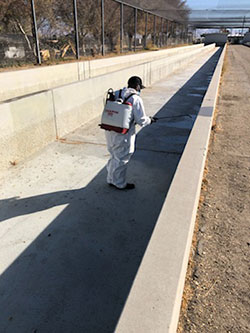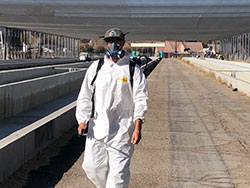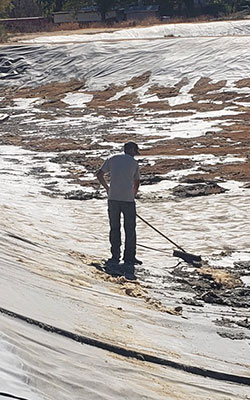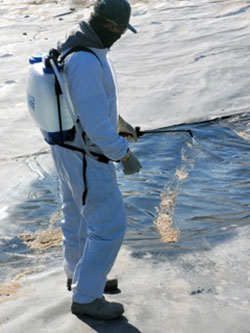One of twenty-four 270 gallon totes of 10% Hydrogen Peroxide staged for raceway application. Hydrogen peroxide is used to kill the L. garvieae bacteria.

Fish and Wildlife Technician at Mojave River Hatchery applying Hydrogen Peroxide to raceways. Over 224,000 square feet of raceway were treated between the three hatcheries.

Fish and Wildlife Technician at Mojave River Hatchery in his Personal Protective Equipment preparing to disinfect the raceways with Hydrogen peroxide.

Hatchery worker cleaning debris from the hatchery settling pond to prepare for disinfection. Hatchery staff removed several yards of debris by hand to prevent tearing the rubber liner used to protect local ground water.

Hatchery worker spraying hydrogen peroxide on the settling pond liner to kill L. garvieae bacteria.
Eight months after a bacterial outbreak in CDFW fish hatcheries led to the massive depletion of stocks, state fisheries biologists are still working hard on recovery efforts and a plan to stock California’s waters for anglers in 2021 and beyond.
Prior to the initial discovery at the Mojave River Hatchery in April 2020, the bacteria, Lactococcus garvieae, had not been found in California in aquaculture facilities or in the wild. Extensive testing of all CDFW hatcheries found the bacteria to be present in fish at the Fish Springs Hatchery and Black Rock Hatchery as well. Fish at all three hatcheries were immediately quarantined and ultimately 3.1 million trout were euthanized after treatment efforts were unsuccessful.
Over the following months, the three hatchery facilities have undergone intensive disinfection and a team of scientists has been working to test a vaccine developed to prevent infection from the bacteria. Meanwhile, fisheries managers at other state trout hatcheries are working on a joint effort to realign how the trout stocks statewide will be apportioned in order to continue to provide angling opportunities.
Most of the trout affected by the outbreak were destined for Eastern Sierra and Southern California waters. Seven state hatcheries not affected by the bacteria instituted a redistribution plan of healthy fish stocks making trout available to a subset of priority waters normally planted by the hatcheries that were quarantined.
Another priority has been to find or develop an effective vaccine, according to Jay Rowan, CDFW Statewide Hatchery Program Manager. Dr. Mark Adkison of CDFW’s Fish Health Laboratory is leading the state’s efforts in coordination with Dr. Esteban Soto of the UC Davis Aquatic Animal Health Lab in the UC Davis School of Veterinary Medicine. Although there are commercially produced vaccines available, scientists found that they most likely would not protect fish against the genetically distinct strain of L. garvieae bacteria affecting the fish in California’s hatcheries. Together, the scientists have been focused on making an “autogenous” vaccine, produced with the strain of L. garvieae bacteria that is unique to California. The vaccine is currently undergoing laboratory trials.
While the vaccine is being developed, hatchery managers have been hard at work disinfecting the affected facilities. After specialists from UC Davis ran experimental treatment scenarios to determine the most effective disinfectant options, CDFW was able to select and enact a comprehensive treatment plan. All surfaces and equipment were thoroughly cleaned and then disinfected with hydrogen peroxide at a concentration shown to remove biofilms and inactivate the bacteria. These measures were completed in December.
CDFW Fish Hatchery Manager Paco Cabral describes the effort as “lots of work.” Cabral was in charge of the massive and meticulous cleaning regimen to remove the bacteria from Mojave River Hatchery. Every surface that has come into contact with hatchery water requires disinfection -- including the hatchery building tanks, raceway holding ponds, settling ponds, pipes and all related fish rearing and planting equipment, and fixtures such as screens, nets and planting trucks. Even the staff’s waders and boots have to be disinfected.
To cleanse 6,000 feet of concrete raceways, staff utilized a 250-gallon high pressure spray washer to clean algae and dirt off each of the 10-foot by 1,000-foot structures. Once this is complete, backpack sprayers are used to apply a mixture of water and hydrogen peroxide to break down and kill the bacteria. Without these extensive measures, the bacterial will form a protective biofilm allowing it to survive even in the harsh dry conditions of the Mojave Desert in the summer and freezing cold conditions in Eastern Sierra in the winter.
Inside the hatchery buildings, all surfaces -- from incubation structures, tables and trays to faucets and hoses – must be disinfected. The cleaning process also includes all the hatchery plumbing, which is disinfected with the same hydrogen peroxide solution delivered via a gas-powered, high-pressure drain cleaner.
Over the summer, CDFW launched Phase 1 of the stocking plan by reallocating 40,000 catchable fish from central and northern California hatcheries to 16 waters in the Eastern Sierra and Southern California that would have normally been stocked by the infected hatcheries. Decisions about which waters would be stocked were not made lightly; fisheries managers carefully evaluated all options and selected locations based on angler accessibility and suitable water temperatures. Justin Kroeze, Fish Hatchery Manager at Moccasin Creek Hatchery, reports that during July, August and September, the staff from his hatchery were able to plant east side waters with 12,000 pounds of trout.
In Phase II of the stocking plan, which took place in October and November, CDFW reallocated and completed planting approximately 30,000 sub-catchable brown trout and 125,000 sub-catchable rainbow trout from American River Hatchery near Sacramento to Eastern Sierra waters. These fish are intended to be “put and grow,” available to anglers for the spring 2021 trout openers. They were reallocated from the June 2020 high elevation air plants that were cancelled due to staff safety concerns for COVID-19.
In December, Moccasin Creek Hatchery and San Joaquin Hatchery transferred approximately 125,000 rainbow trout to Fillmore Hatchery for stocking into Southern California waters during the December-through-March timeframe. These transferred fish join the approximately 500,000 rainbow trout already at Fillmore Hatchery that are getting close to reaching planting size. Moccasin Creek Hatchery plans to transfer an additional 40,000 rainbow trout to Fillmore in the coming weeks to assist in stocking efforts.
“It feels good to be able to help out the closed hatcheries and plant fish for the anglers in the Eastern Sierra and Southern California,” Kroeze said. “We’ve been in a similar situation here at Moccasin with no fish to plant, so we understand the situation they are in.”
Anthony Holland, Fish Hatchery Manager at Fillmore Hatchery, said that his staff are working to do everything possible to provide fishing opportunities for anglers in Southern California by planting out and holding incoming fish from the northern hatcheries. These plants are being posted on the CDFW trout planting schedule one to two weeks prior to the stocking date.
“We’re getting these fish out as fast as we can to provide angling opportunities to Southern California,” Holland said. “It’s been a while since these waters have been planted, so it’s great to see fish going in and people catching fish.”
In addition, Moccasin Creek Hatchery and San Joaquin Hatchery are holding approximately 400,000 sub-catchable trout for future transfer to the three depopulated hatcheries to help give them a jump start in their efforts to return to planting the waters in their areas in 2021. These trout were made available due to the decision last year to hold and grow extra trout at Moccasin Creek Hatchery once the hatchery came back online after major flood repairs were completed. Once the three affected hatcheries are back online, the number of waters planted will increase dramatically as an annual cycle of rearing is completed. It takes approximately 9 months to 18 months to rear a trout to one-half pound, which is the targeted size for catchable planting.
For additional information, please see  CDFW’s frequently asked questions about the L. garvieae outbreak (PDF). Please email questions to hatcherybacteriainfo@wildlife.ca.gov.
CDFW’s frequently asked questions about the L. garvieae outbreak (PDF). Please email questions to hatcherybacteriainfo@wildlife.ca.gov.
###
Media Contact:
CDFW Photos